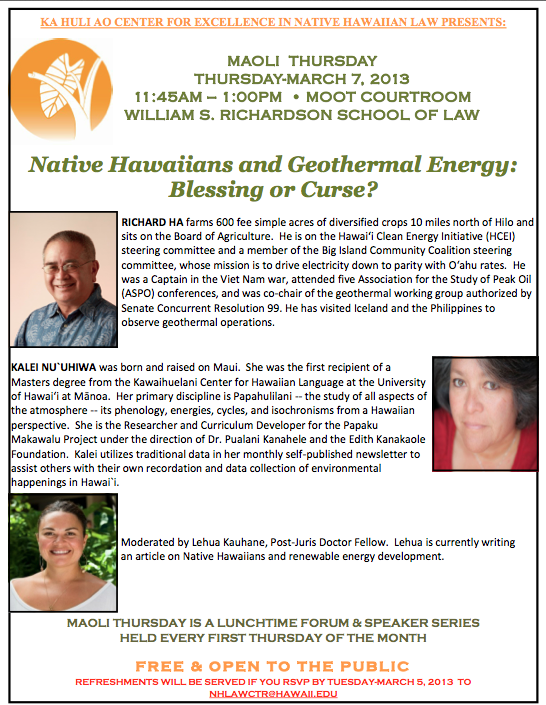Richard Ha writes:
Although we are testifying in strong support of HB106 HD2, SD1, we would support any bill or combination of bills that further our efforts to bring lower-cost electricity to the Big Island in a pono way.
Aloha Chair Gabbard and Vice Chair Ruderman:
The Big Island Community Coalition (BICC) is strongly in favor of HB106 HD2, SD1.
The BICC steering committee members are Dave DeLuz, Jr., President of Big Island Toyota; John E. K. Dill, Chair of the Ethics Commissions; Rockne Freitas, former Chancellor, Hawai‘i Community College; Michelle Galimba, Rancher and Board of Agriculture member; Richard Ha, farmer, Hamakua Springs; Wallace Ishibashi, Royal Order of Kamehameha; Ku‘ulei Kealoha Cooper, Trustee, Kealoha Estate; D. Noelani Kalipi, who helped
write the Akaka Bill; Ka‘iu Kimura, Director of Imiloa Astronomy Center; Robert Lindsey, OHA; H. M. (Monty) Richards, Rancher; Marcia Sakai, Vice Chancellor, University of Hawai‘i at Hilo; Kumu Lehua Veincent, Principal, Kamehameha High School, Kea‘au; William Walter, President, Shipman Estate. All speak here in their private capacity.
Our mission is to drive down the cost of electricity on the Big Island. The cost of the Big Island’s electricity has been 25 percent higher than O‘ahu’s for as long as we can remember. Yet the Big Island has the lowest median family income in the state. Three school complexes in East Hawai‘i lead the state in free and subsidized school lunches: Pahoa at 89 percent, Ka‘u at 87 percent and Kea‘au at 86 percent.
Education is the best predictor of family income. But because the Big Island’s electricity rate is 25 percent higher than O‘ahu’s, we waste more than $250,000 annually in some of our school complexes.
The cost to generate electricity from geothermal is less than half that of oil. And because the Big Island will be over the hot spot for more than 500,000 years, that cost will be relatively stable – unlike the cost of oil, which will rise in the not-too-distant future.
I asked Carl Bonham, Executive Director of the UH Economic Research Organization, if it is fair to conclude that if geothermal were the primary base power for the Big Island, then the Big Island would become more competitive to the rest of the world as oil prices rise? He said, Yes, we would become more competitive. I concluded, and he agreed, that our standard of living would then rise. And that our working homeless could get off the streets.
We all need to work together to make things work. Get thousand reasons why no can! We only looking for the one reason why CAN!
Richard Ha
BICC Steering Committee Representative



